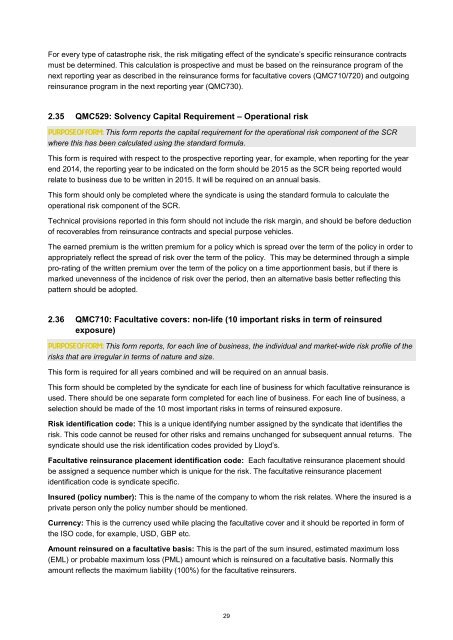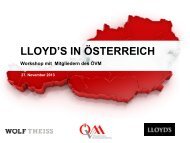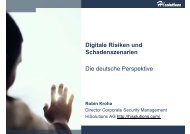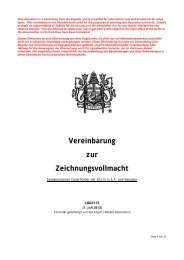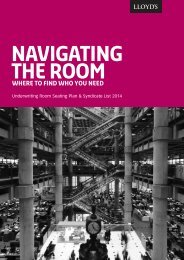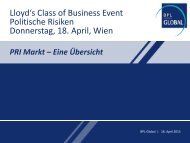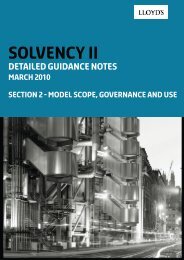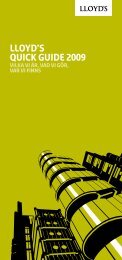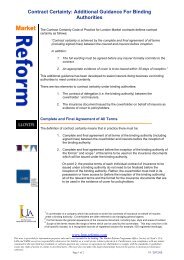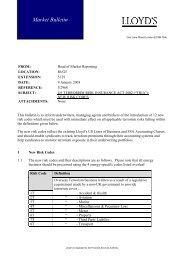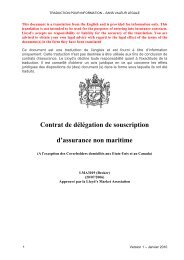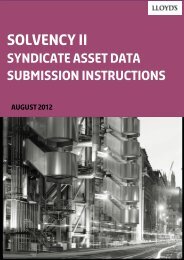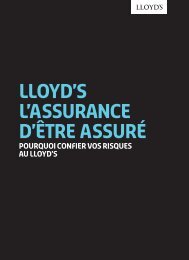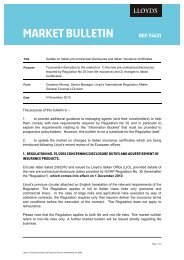Create successful ePaper yourself
Turn your PDF publications into a flip-book with our unique Google optimized e-Paper software.
For every type of catastrophe risk, the risk mitigating effect of the syndicate’s specific reinsurance contracts<br />
must be determined. This calculation is prospective and must be based on the reinsurance program of the<br />
next reporting year as described in the reinsurance forms for facultative covers (QMC710/720) and outgoing<br />
reinsurance program in the next reporting year (QMC730).<br />
2.35 QMC529: <strong>Solvency</strong> Capital Requirement – Operational risk<br />
Purpose of form: This form reports the capital requirement for the operational risk component of the SCR<br />
where this has been calculated using the standard formula.<br />
This form is required with respect to the prospective reporting year, for example, when reporting for the year<br />
end 2014, the reporting year to be indicated on the form should be 2015 as the SCR being reported would<br />
relate to business due to be written in 2015. It will be required on an annual basis.<br />
This form should only be completed where the syndicate is using the standard formula to calculate the<br />
operational risk component of the SCR.<br />
Technical provisions reported in this form should not include the risk margin, and should be before deduction<br />
of recoverables from reinsurance contracts and special purpose vehicles.<br />
The earned premium is the written premium for a policy which is spread over the term of the policy in order to<br />
appropriately reflect the spread of risk over the term of the policy. This may be determined through a simple<br />
pro-rating of the written premium over the term of the policy on a time apportionment basis, but if there is<br />
marked unevenness of the incidence of risk over the period, then an alternative basis better reflecting this<br />
pattern should be adopted.<br />
2.36 QMC710: Facultative covers: non-life (10 important risks in term of reinsured<br />
exposure)<br />
Purpose of form: This form reports, for each line of business, the individual and market-wide risk profile of the<br />
risks that are irregular in terms of nature and size.<br />
This form is required for all years combined and will be required on an annual basis.<br />
This form should be completed by the syndicate for each line of business for which facultative reinsurance is<br />
used. There should be one separate form completed for each line of business. For each line of business, a<br />
selection should be made of the 10 most important risks in terms of reinsured exposure.<br />
Risk identification code: This is a unique identifying number assigned by the syndicate that identifies the<br />
risk. This code cannot be reused for other risks and remains unchanged for subsequent annual returns. The<br />
syndicate should use the risk identification codes provided by Lloyd’s.<br />
Facultative reinsurance placement identification code: Each facultative reinsurance placement should<br />
be assigned a sequence number which is unique for the risk. The facultative reinsurance placement<br />
identification code is syndicate specific.<br />
Insured (policy number): This is the name of the company to whom the risk relates. Where the insured is a<br />
private person only the policy number should be mentioned.<br />
Currency: This is the currency used while placing the facultative cover and it should be reported in form of<br />
the ISO code, for example, USD, GBP etc.<br />
Amount reinsured on a facultative basis: This is the part of the sum insured, estimated maximum loss<br />
(EML) or probable maximum loss (PML) amount which is reinsured on a facultative basis. Normally this<br />
amount reflects the maximum liability (100%) for the facultative reinsurers.<br />
29


